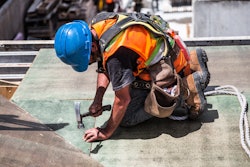
The Marcum Commercial Construction Index for the fourth quarter of 2020, produced by Marcum LLP's national Construction Services Group, reports that the industry has reasons for optimism and pessimism as it recovers from the recession caused by COVID-19. Total construction employment has rebounded since plummeting in March and April but remains 3.3% below pre-pandemic levels.
“Nonresidential construction employment declined by about 644,000 jobs between February and May of 2020 as the pandemic’s grip took firm hold,” wrote Anirban Basu, author of the report and Marcum’s chief construction economist. “As of January 2021, the nonresidential industry had recovered about 60% of those losses, which means that the segment’s employment is still 5.5% lower than it was at pandemic’s onset.”
Dr. Basu points out that the residential segment has boomed over the past several months. “The story in residential construction segments has been vastly different," he noted. "Mass migration toward the suburbs, triggered in part by the pandemic but also by underlying demographics, has helped launch a single-family housing construction boom.”
Construction spending data indicate that nonresidential spending contracted 5.7% on a year-over-year basis in December 2020. “Among the most damaged segments were retail, hotel room, and traditional office space construction,” the report says. “Based on leading indicators, near-term dynamics will not be positive in many nonresidential segments. Among the exceptions are data centers and fulfillment centers.”
Construction input prices have not been subject to rampant inflation thus far, although Dr. Basu warns that could change due in part to elevated shipping costs. “With so many construction commodities shipped from various parts of the world, it is remarkable that there hasn’t been ever more construction input price inflation. The reconciling factor is likely the diminished demand for inputs to construction in much of the pandemic-hammered world.”
Marcum predicts that the economy will expand rapidly in the second half of 2021, but that nonresidential construction may take longer to bounce back. “In recent cycles, the recovery of nonresidential construction spending has tended to lag that of the overall economy by 12 to 18 months. If that formula remains in place, solid macroeconomic recovery this year should translate into more exuberant expansion in nonresidential activity in 2022 and/or 2023.”
Marcum’s national construction leader, Joseph Natarelli, said, “Non-residential construction is slow at present. However, in this latest index, we highlight possible pathways up and out. If you’re in the infrastructure subsector, the outlook is especially positive, with most infrastructure subsectors trending up. Will there be a new New Deal from the White House? We don’t know that for certain yet, but if contractors can look into ways that their current operations can innovate in that direction, it is likely to pay dividends in years to come.”

















